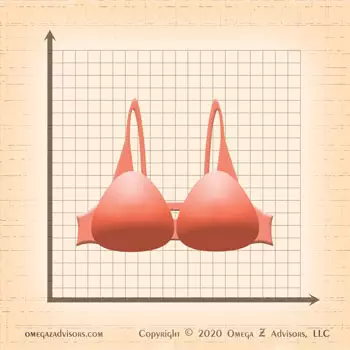Bra Sizing As Case Study For Questioning Statistics Effectively
Bras are the most complex everyday garment to make. While other garments might have five to ten components, bras have about sixty. This makes bra sizing a great everyday case study for questioning statistics effectively.
Questioning Statistics With Three Questions
Statistics easily intimidate people. If they don’t, they fool the rest, especially if they say good things.
Yet, in truth it’s easy to challenge statistics with three basic questions:
- How did they count (or measure) the thing told by these numbers?
- How different were the things that they counted?
- What assumptions did they make to ensure they were able to come up with good, clean numbers?
Here, bra sizing makes a great case study for seeing how these questions apply.
Bra Sizing, The Case Study

Statistics easily intimidate and fool people. Studying the sizing of bras and even other garments shows how to challenge statistics without being statisticians.
In regards to the first question, bra sizing uses two measurements. The first goes around the chest just below the breasts called “band size.” The second goes just above that over the highest point of the breasts, “bust size.” Subtracting band size from the bust size gives “cup size.” The bust size combines with the cup size to give bra size (34B, 40C, 46D, etc.).
As for the second question, “How different are breasts?” Turns out very different. They aren’t just smaller or bigger. Shaping varies from one woman to the next. Often their sizes aren’t the same even on the same woman.
As for the third question, the main assumption is that breasts have the same shape, they’re just bigger or smaller. Think of a house. These measurements say we can measure the size of a house by knowing just its height. In other words, they say that if a breast’s height doubles its other dimensions will move the same way on all breasts.
Statistics And Bra Sizes Not Always Fitting Well
Bras don’t fit well. Just ask a woman. These answers to these questions show why too. Bra sizing is based on assumptions about shapes of breasts. All statistics use assumptions too. It’s a matter of finding them,
For instance, take polling. “Who will you vote for?” This simple question assumes that the person will vote. That’s why pollsters look at how often and recently the person voted. The answer’s value in predicting elections hinges on it.
Take unemployment. How many are out of work? Kids who aren’t allowed to work don’t count. What about those in college? Employees who lost their jobs went back to school? Became self-employed until something came up? Took part-time jobs while looking for full-time? All these questions produce assumptions about the count.
Finally, look at your clothes. “Vanity sizing” makes us feel good. This happens with all statistics under the guise of “making them easier to understand.” Thus, challenging them is important.
So, if you don’t wear a bra, the point is this. To challenge statistics effectively, think about your clothes. What do you need to ask about the sizing to ensure they fit? Those questions and the ones in this post will serve as a great guide.



As a woman and one that does fitting for larger women, gosh, I know the dilemma. Thanks for sharing this story.
Thank you, Peggy, for the feedback. You’re welcome. Its complexity made a good study for challenging statistics. I also I used to work in retail, a buyer in a woman’s area. I also found that when people don’t fit the standard models, it’s easy for them to wonder if there is something “wrong” with them. The standards are the problem. Humans are unique. They don’t fit standards. Again, thank you.